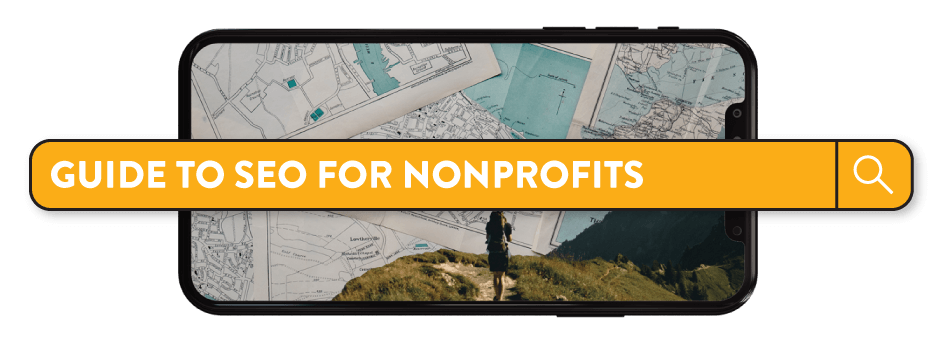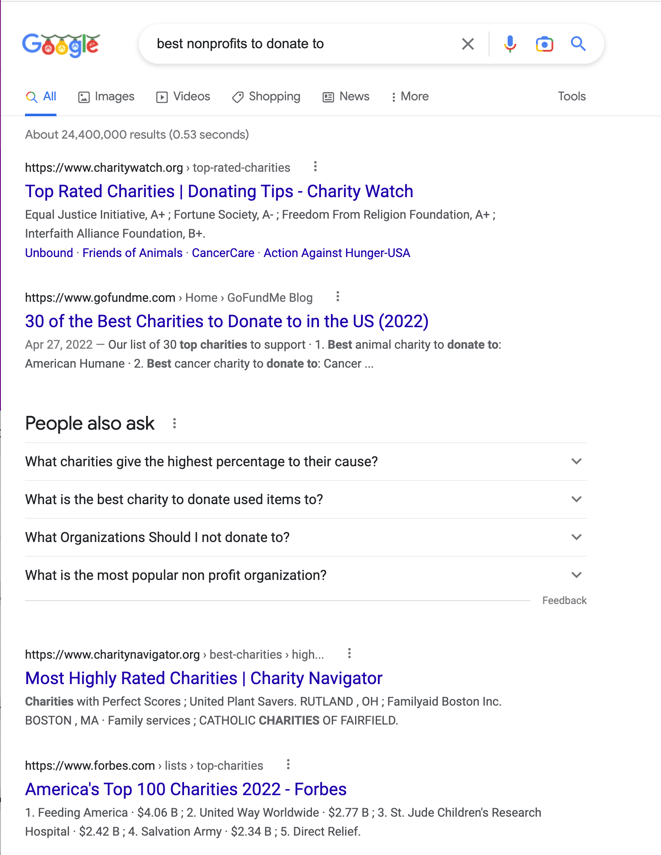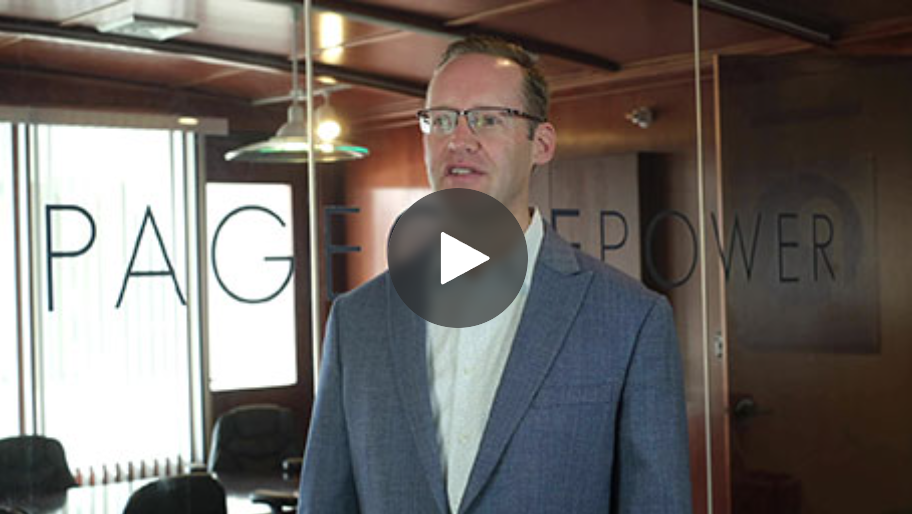A GUIDE TO SEO FOR NON-PROFIT ORGANIZATIONS


Search engines like Google facilitate billions of searches every day, connecting people with businesses, entertainment, news, and more. The amount of search activity means it can be highly lucrative to optimize your site for discovery in search — also known as search engine optimization, or SEO.
SEO is an essential consideration for nonprofits today because every group nonprofits need to reach — donors, volunteers, and clients who receive the services or are the target of the group’s mission — is likely to look online for information first. That means your best chance to survive and thrive is to have a website that announces clearly and consistently who you are, who you serve, and how the community can contribute through volunteer service or monetary support.
Powerful SEO doesn’t have to cost a fortune. If you already have a website, or already have plans to make one for your organization, then a few simple considerations could end up saving you both time and money, priming your site for organic discovery in search.
If you want a concise guide to what you can do now to improve your SEO, keep reading!
A quick list of beginning SEO resources.

If you need more help with the basics or want to learn more about the key elements of SEO, the links below can help you start your journey. Of course, if the DIY approach isn’t for you, you can always find an SEO partner to help you through whatever aspects of SEO you find challenging. Our team of SEO experts is also available to answer your questions, take a closer look at your site, and put a custom campaign together for you.
- SEO Glossary: This is a great first stop for complete novices, and a helpful resource to refresh your memory of SEO terms, jargon, and important concepts.
- Keyword Research Guide: Whether you want to complete your own keyword research, or want to understand how it should be executed by your SEO partner, this primer covers all the important steps and considerations.
- Keyword Content Services: If you are looking for help with keyword research, or employing it as part of your content creation strategy, this is a starting point for building a partnership you can trust.
- Link Building Guide: Earning links is consistently rated as one of the most difficult SEO processes, but it is also one of the most important. Learn the fundamentals here.
- Link Building Services: In-house link building is a time-intensive process; if you’re looking for help or an outsourcing partner, look no further.
- Technical SEO: Depending on how old your website is, or how many times it has been updated or redesigned, there could be all manner of technical issues impeding your search performance. Learn some of the most common problems here.
- SEO Auditing: Knowing what to look for and how to find it can be one of the harder aspects of improving your technical optimization; get help from the pros here.
Google My Business: Any organization with a physical location or a local presence needs to have a Google My Business (GMB) profile set up and managed. This is your best resource for getting started.
How does SEO for nonprofits work?

SEO generally works the same for all websites, including nonprofits:
- Discovery by Engines: Search engines find your site, “reading” the content on each page and indexing it as a possible answer to common queries and associating it with relevant keywords.
- A Search for Keywords: When someone enters these keywords into a search engine as part of a query, the search engine reviews all the sites and pages it indexed before, based on how relevant they seem to the keywords in the query, the quality of the content on the site, and how credible or reliable that website seems to be compared to similar sites.
- Ranked Results: The search engine “ranks” these pages and displays them to the searcher in a search engine results page, or SERP. Typically, the higher a page appears in the SERP, the more attention and traffic it gets, which means more people visit that website.
SEO is a matter of establishing the signals of quality, credibility, and reliability that search engines look for when assessing and ranking possible results.
SEO for nonprofits is in some ways a lot simpler than it is for most organizations, if only because nonprofits tend to serve missions and communities that don’t get a lot of competition from the marketplace. While e-commerce shops and news sites must compete for every click and every keyword in their space, nonprofits stand out by filling essential gaps in who they reach and how they help.
Less competition generally means it is easier to appear in SERPs and be discovered by whoever is looking for information. It also helps reduce the expense of starting or maintaining an SEO campaign, which is great news for the nonprofit sector.However, nonprofits also have a unique challenge — in that they must be visible to three distinct groups online: their clients (those they serve), their donors, and their volunteers. So while ranking factors work the same way for nonprofit websites, there is an added challenge in having equally clear messaging and online content for all three of these core audiences and making that messaging coherent and consistent for search engines.
The four pages every nonprofit website needs.

If you want the simplest, most cost-effective way to optimize your site for search, this is it. These four pages are the building blocks of your organization’s online identity and visibility; while there are lots of ways you can improve and expand your site with additional content, these are the absolute essentials.
We’ll expand on tips and best practices for each of these, but for starters, know that you will need:
- Homepage;
- Volunteer page;
- Donor page;
- Mission page.
And that’s it! You can have a successful, useful website as a nonprofit with just these four pages. How you optimize these pages precisely will depend mostly on the details that make your organization unique, but if your goal is just to be found online by your three core audiences, these are the pages that search engines will need to be able to see.
HOMEPAGE

The most important page on your site when it comes to establishing what keywords are relevant to your organization, and what types of searches your domain should appear in, is your homepage. This is the starting point for most visitors, and crawlers discovering and indexing your site. For visitors and search engines alike, the homepage is essential to get right.
Just remember: simple is best. One of the big mistakes that many nonprofits — and organizations or sites of all types, for that matter — make, is trying to do too much with the homepage. You might be tempted to drop all kinds of information here, turning your homepage into an infinite scroll. There are a few key problems with this approach, but the most critical one is that it just doesn’t make for a good user experience. Your goal should never be to force visitors to “work” to learn about you or engage with your website. So when designing your home page, keep it simple and succinct, and focus on communicating a few essential pieces of information. Be sure to use clear, prominent internal links to guide visitors to deeper landing pages for more information.
WHO YOU ARE

This is a good place to develop and display an elevator pitch: a short, memorable, and direct description of the mission and identity of your nonprofit.
Using our own website as an example:

We echo the title tag, and follow it up with, “The world’s finest link building agency.”
There will be room elsewhere to elaborate on this and describe your services, your clients, and more in detail, but it is important to set the tone — and establish your most important keywords — here, early, on the home page.
WHAT YOU DO
Now, you can detail what it is that you offer. This may fit into your elevator pitch that explains who you are — as your identity is tied to your mission. However, it may make sense to elaborate on your mission.
For example: If “Who We Are” is, “a free medical clinic serving low-income individuals and families in our community,” then it would make sense to elaborate on the specific services you offer: Dental? Surgical? That is something to address here on the home page, as concisely as possible.
You don’t need to be exhaustive on your home page — you just need to establish the core keywords you want to be associated with, and that you expect people to use in search to find you.
WHOM YOU SERVE

Part of explaining who you are and what you do should include specifying whom you serve. You don’t have to be exhaustive here, but if part of your mission is being discovered by a specific population or demographic, you’ll need to make that clear on your homepage.
This way, potential clients who discover you will know they’ve come to the right place; prospective volunteers and donors will likewise see immediately if the groups you serve align with their interests and goals.
Do your clients need to apply first? Do you screen applicants for specific information, like income level or where they are a resident? Explain that here. Don’t make the people you serve have to hunt down critical information; lead with the essentials.
VOLUNTEER PAGE

If you accept volunteers or have opportunities and positions you are actively trying to fill, you should mention that on your home page — briefly. You don’t need an exhaustive list on your home page, just a mention that allows you to link internally to a dedicated volunteer page.
This page should align with your home page, speak to your mission, and discuss how volunteers contribute to that mission. Depending on the type of organization you operate, you may need more sections on this page, or even separate pages dedicated to specific types of volunteers. For example, if you are a free medical clinic, then you may have a different landing page for clinically licensed and certified volunteers than for positions that don’t require this licensing.
The volunteer page should be dedicated to giving people who are interested in helping out all the information they need to get started — and making it clear what requirements, if any, they need to meet before reaching out.
OPPORTUNITIES AND POSITIONS AVAILABLE

This section of the volunteer page should resemble a typical Careers page or a job listing. If you have a few basic positions or opportunities, it is ok to detail them all on one page. If you have a lot of diverse positions and needs, or your needs regularly change, then it may make more sense to use this landing page as more of an overview, and create a separate landing page for each position needed.
Either way, you’ll need to explain each role that volunteers can fill and include details like:
- Responsibilities and duties associated with each role;
- Times or working hours volunteers need to fill;
- The level of commitment volunteers should expect;
- Locations accepting volunteers.
Let them know what to expect, and figure out for themselves if they are a good match.
QUALIFICATIONS AND SCREENING

If your volunteers need special skills, credentials, licenses, or specific training, you’ll need to share these details. Not only does it help visitors determine if they are the right fit, but it also populates the page with additional descriptive keywords that search engines can use to bring searchers to you.
HOW TO APPLY

The last piece of information you must include on the main volunteers landing page is instructions for how volunteers should contact you, submit applications, or otherwise connect. If you require a formal application, you should provide a link to that on this page, or else indicate where the application can be downloaded, along with instructions on how to submit it.
If you prefer all volunteers reach out, that is okay too — just make sure you include the contact information for your volunteer coordinator, even if it is just an email address or phone number. Whatever your process, it is important that you make it visible and actionable for visitors.
DONOR PAGE

Those who give to nonprofits comprise a large, diverse group, so more detail is better when it comes to the donor page. It would make a lot of sense to design the main donor page as a landing page linking to more specific, targeted pages with all of the information below, but if you are short on resources and need to keep things simple, a well-organized single page can suffice.
There are just a few essential elements to include for your donors:
WAYS TO DONATE

This is the most important. Depending on your mission and organization type, you may favor in-kind donations — for instance, accepting toys to be gifted to children, or thrift items to be resold in your store.
People may be searching for specific types of in-kind donations they wish to give, so be detailed about what your needs are and what you accept. Likewise, you should detail what you categorically cannot or will not accept as a donation, to save both you and prospective donors time.
In addition to the different types of donations you accept, be sure to provide a clear pathway for different ways to donate. How do you receive cash gifts? Can donors contribute electronically through your website (and have you clearly established that it is secure for them to do so)?
Individuals and households are not the only potential audience for this page. Organizations — from churches and youth groups to local corporations and businesses — may all be interested in supporting you, with fundraisers or organized giving. Detailing how they may do so, or even just providing a contact form for them to fill out, can increase the chances of you being discovered, and supported by these types of community partners.
FINANCIAL REPORTING

Many audiences will want to see a more detailed picture of your finances. This should probably receive its own dedicated page, as well as a link to download a PDF for each year’s financial report.
Donors, especially large organizations or major contributors, may want to see exactly how far their contributions will go, or how their gifts will be used. It is standard for donors to wish to see that resources are used responsibly and that your spending reflects your stated mission. A detailed, accessible spending and earning report can placate all these concerns, and demonstrate your transparency and credibility as a nonprofit.
There are also many websites that aggregate lists of nonprofits, organized by type or location, and rank them based on several factors, including transparency and fiscal responsibility. By providing this information directly on your site — and consistently updating it every year or reporting period — you can take ownership over how your organization is represented and assessed by these third parties. Many donors will use platforms like these to seek out, assess, and select nonprofits to support. Sharing your financial profile is a key aspect of SEO for nonprofits.
MISSION PAGE

While your homepage serves as an elevator pitch for your organization’s mission, it should not be exhaustive. It should serve as a hub that directs visitors to each of your main pages for more information. Donors, volunteers, clients, and the general public may wish to learn more about your activities, and the mission page is your opportunity to elaborate.
MORE DETAILS TO WHOM YOU SERVE

Whether you serve individuals in your local community or sponsor groups and initiatives around the world, visitors will want to know more. Offer the full details like how your clients find you, or how you find them. Do you accept applications from clients or other beneficiaries?
This is also important if your mission doesn’t serve people directly but is dedicated to an environmental cause, a form of lobbying or civic activism, or any other mission not focused on individual clients. Your mission page should expand upon your values, your goals, your priorities, and your means of operation.
MORE DETAILS ON PAST PROJECTS

Your mission page can also detail past successes. This can help showcase exactly how you operate, what makes you an effective organization, and what you consider an accomplishment. Anecdotes, detailed stories, testimonials, and images that help communicate what you have done so far belong here.
It may also be appropriate to detail challenges you had to overcome, or barriers that you continue to face. Connecting past projects to ongoing tensions creates more opportunities for you to call on volunteers and donors to support you — and creates a context for linking to your other core pages.
MORE DETAILS ON CURRENT PROJECTS

Similarly, explain what you are working on presently. If you have an ongoing mission, as with a free health clinic or a thrift store, you can also detail that here.
Explaining what is in the works right now is also a great call to action for donors and volunteers, and further establishes your credibility as an active, responsible nonprofit worthy of support. The more details you offer here, the more keywords you begin to associate your brand with — or deepen your association with the core keywords from your home page. Both are powerful ways to improve your SEO signals and ultimately your visibility in search.
ABOUT US AND HISTORY

In addition to a detailed mission page, you may want a separate landing page dedicated to explaining your origins and history. A short couple of paragraphs may fit on the mission landing page, but a more detailed narrative probably warrants a separate page.
This should be less about idle trivia, and more about establishing longevity, reasserting commitment to your mission or showcasing community connections. This can also be a place to link externally to historic partners involved with your founding, or to other external sources that offer more details on the cause you champion or obstacles you confront.
How to optimize your nonprofit website for search.

Next, you need to consider how to build these pages — and any other pages you decide you want on your website — in a way that consistently demonstrates Expertise, Authority, and Trust across your domain. Also called E-A-T for short, these terms describe the many different ranking factors search engines will use to assess your content and evaluate the relevance of your brand to different searches and keywords.
Regardless of the specifics of your particular mission, there are a few tenets of good SEO that will serve you and your visitors indefinitely. While you can certainly invest in more sophisticated website design and features, the following list covers the absolute essentials for creating a website that is useful and visible to the people you want to reach.
1. KNOW YOUR AUDIENCE

All SEO should be in service of the readers you wish to reach. Search engines are not the audience of your site or your organization; they are a means to help your real audience discover and engage with you. If you keep your core audiences — clients, donors, and volunteers — front of mind whenever you create a page, you will already be optimizing your site for their searches.
Part of knowing your audience means understanding their intent. Searcher intent describes what searchers are looking for, regardless of the query or keywords they input to the engine. If you understand searcher intent and create your content with a focus on delivering what people want, you should naturally and contextually use the kinds of keywords and search terms they will use to find you.
The best keyword research will show you exactly what terms searchers use and at what rate or monthly volume. If you have the resources, you can get professional keyword research from expert SEO partners, or access professional tools to undertake the research yourself. While this is optimal, tools and experts don’t understand your audience better than you, so all the keyword data you get must still be tempered by your knowledge of your target audience and their intent.
2. BE CLEAR AND CONSISTENT

Consistency and repetition are key aspects of solid SEO. While the exact language or keywords you use should naturally be varied, the essence of your message must be clear and consistent across every page. For example, there may be many pages where it makes sense for you to present contact information to visitors. Be wary of typos, and make sure if a contact changes (new email addresses, phone numbers, etc.) you update all instances of that contact information across your site.
If your nonprofit has a physical presence in the community, it will be similarly important to ensure the name, address, and contact information (usually a phone number and email) are consistently displayed across your site. Usually creating a boilerplate footer to occupy the bottom of every page will suffice.
If you have multiple locations or have a different main office than where your volunteers or clients will visit, that information must be made clear. Creating and maintaining a Google My Business profile will also be essential here so that searchers using Maps can find the correct address.
3. KEEP IT SIMPLE, MAKE IT FAST

With searchers and browsers increasingly favoring mobile devices, the speed of your site is a major ranking factor in search and an important aspect of user experience. Outside of a full technical audit, your best bet is to keep things simple. Compressing images and employing a simpler design theme can help ensure your site speed is optimal.
Unfortunately, there are other technical aspects to consider here. A quick and easy (and free) way to determine if technical issues are hurting your site speed is to use Google’s PageSpeed Insights Tool. This provides a simple pass/fail evaluation of a page’s load speed, but also offers more detailed and technical analysis to help you pinpoint specific issues.
Just remember: this is a matter of importance to all visitors, whether they find you through search or otherwise. The fact that page speed benefits SEO is a bonus.
4. BROADCAST YOUR PARTNERSHIPS

A critical element of establishing your E-A-T as a website is earning links from other sites. Just as the links you provide to external sources bolster your credibility by association, external links from other sites to yours act as votes of trust on the web.
An easy way to get started is to be loud and proud of any community or corporate partnerships you have currently, or previously. Link to major supporters’ websites, organizations that participated in fundraisers, or sent teams of volunteers to work with you.
If a relationship exists between your nonprofit and another online entity, make it tangible by linking to them. In return, it is reasonable that they should link back to you, and it is perfectly acceptable for you to ask.
Backlinks seldom happen by accident, so as you go about the usual business of your nonprofit, keep an eye out for opportunities to request or suggest a link to your site. If you get covered in the local press or participate in a special event, ask for a link as part of the story.
The more links you earn from these legitimate sources and varied contexts, the better your overall visibility and trustworthiness to search engines. Just don’t fake it: spammy links from random sources or irrelevant contexts will send the opposite signal of what you want. Good links come from genuine relationships, so as you grow your relationships and partnerships, actively solicit the links that reflect these real-world connections, online.
5. KEEP UPDATING

SEO is not a one-and-done endeavor. While following these guidelines for the initial creation or refurbishing of your website will give you a solid SEO foundation, your efforts must persist to be effective. Earning links from your partners and supporters will require you to thoughtfully ask, each time it makes sense to do so. As turnover changes the points of contact for volunteers and donors, you must update your website to keep it accurate and useful.
You must update your financial reporting consistently, so prospective donors can see the most current spending and earnings. Your mission page, too, will benefit from the occasional refresh, sharing new success stories and detailing new or ongoing challenges and goals.
Freshness matters on the web — to visitors and search engines alike. By maintaining and updating the pages on your site, you help signal to search engines that someone cares and that your site remains as credible and useful as ever. Even something as simple as publishing a monthly blog or newsletter to your site can help showcase maintenance to search engines, as well as provide visitors and supporters with opportunities to learn and engage with you.
Off-site optimization matters too.

SEO, discovery, and traffic to your site ultimately depend on more than just your site. While optimizing your site is unquestionably important, myriad off-site factors influence search rankings. But what’s even more challenging for nonprofits, in particular, is the fact that Google itself is not the only search engine that will refer traffic to your site — at least, not for volunteers and donors.
Most of the time when we talk about SEO, we are talking about Google, but for nonprofits, Google is really most important for a branded search (when someone is searching for your organization by name) and client searches (when the people or communities you serve are looking for the specific services you provide), as well as local navigational queries (like using Google Maps to find your office).
When it comes to most searches conducted by volunteers and donors, Google’s results will not be filled with nonprofits like yours; rather, Google will refer searchers to specialized search engines that act as directories for nonprofits.

This doesn’t mean your onsite SEO efforts are wasted — quite the opposite. What you say about yourself on your core pages is usually the basis for any information shared or written about your organization on these other platforms and directories. That is part of the reason why it is so important to get the details right on your site.
But when it comes to volunteers looking for local opportunities, or donors looking for the right cause to back, they are very likely to find the directories before they ultimately visit your site. While you cannot always directly control how these directories present you or even rank you, there is still a lot you can do to influence them and ensure they are accurately reflecting you to their visitors.
VOLUNTEER RECRUITMENT AND REFERRAL PLATFORMS

Much of the time, a volunteer looking for local organizations or work opportunities will turn to Google and be redirected to one of the following sites.
Some of these operate like traditional search engines, and will automatically find and list nonprofits over time. Others provide a platform for you to add your organization to the list, or post specific volunteer opportunities similar to a job board. Either way, you should be able to claim or create your listing and ensure it remains accurate and updated.
In addition to these major online directories and aggregators, you will need to reach out to your chambers of commerce, state and local government, and possibly even national agencies or organizations, depending on your mission. Potential volunteers will go to a variety of sources to find opportunities, so part of SEO for nonprofits involves establishing and maintaining a profile with these local hubs to aid in discovery.
Local schools, youth groups, places of worship, and similar community hubs can also be important sources of referrals for volunteers, both by word of mouth and online. Reaching out to these organizations — and requesting links from their website where appropriate — can all help bolster SEO for you.
Donor Recruitment Platforms
In truth, the solicitation of donors is not likely to happen online for anything but the biggest, best-known brands and organizations. However, ownership of your nonprofit’s name and brand can be integral to how potential donors research your organization and make donation decisions. This shortlist is a very baseline set of platforms that allow nonprofits to create and own their profiles and can go a long way to supporting your mission and your online visibility.
Amazon shoppers around the world have the free opportunity to make their purchases contribute to a chosen cause by using Smile.Amazon.com. You can register your nonprofit at the link above to make your charitable organization eligible to receive these automatic donations from supporters. Be sure to link your Smile profile from your donor page and add instructions so that visitors know you are on the platform.
LinkedIn may be a social media site targeting professionals and organizations, but it is also a standard reference point for individuals and corporations looking into nonprofit partners and charitable causes. Creating and maintaining a profile for your nonprofit is free, and provides another point of reference for search engines to learn about your organization and make information available to searchers.
In addition to claiming your profile and soliciting volunteers, Great Nonprofits is a great platform for finding and building relationships with donors of all sizes. You can use your profile to set up online giving to accept electronic donations and offers some of the lowest fees for processing these transactions.
GuideStar is a social platform similar to LinkedIn, but designed specifically for nonprofits. It is a powerful research tool donors use to find and assess potential beneficiaries, and it is free for you to create and manage your nonprofit’s profile.
Charity Navigator is another research tool aimed at helping donors make informed decisions about their contributions. This is a major platform that analyzes and summarizes nonprofit financial information, and provides third-party ratings of nonprofits based on a variety of criteria, with an emphasis on transparency and financial responsibility. You can submit your financial reports here for assessment as well as update your organization’s profile.
The Council of Nonprofits is a national clearinghouse for organizations where you can connect with like-minded community groups and other nonprofits. It is also a great resource to create and maintain your profile to meet donors and gain resources to support your mission. Simply find your state’s association to get started.
REVIEWS

Many of the platforms and directories listed above incorporate reviews in some capacity. For some, reviews may be a ranking factor considered when displaying results for a search; for others, reviews may just be another field visible when someone looks at your profile.
Google itself, via your Google My Business profile, may also display reviews next to your listing in the SERP, depending on the query. All this means it is important to be proactive in soliciting reviews — from volunteers, donors, and community partners, but also from the groups you serve as clients.
MEET YOUR PARTNERSHIP DEVELOPMENT TEAM
You need relevant, reputable links and strategic, well-written content to grow your brand. We've got 13+ years of experience doing just that for our clients, and we're ready to help you.



BY THE NUMBERS

The People Who Know, Know
See how we’ve helped businesses like yours achieve lasting SEO growth.

In a sea of questionable and spammy link building providers, Page One Power is someone that you can trust and someone that will get you good results.

Thanks to Page One Power's efforts, the client has seen an improvement in Google keyword pages and gained quality links. The team has conducted regular meetings to provide progress updates and quick responses. Their transparency and extensive research are notable in the partnership.
Coming from an agency background, I can really see exactly how a good agency would retain their clients for a long time...and of course the opposite way around. The work is good, the numbers are good. They stand behind whatever they say, and the way they conduct their business is very professional.

I have used Page One Power for many years to build high quality links for multiple web properties. They take great care of their customers and I couldn't ask for a better partner. I highly recommend.

I've always found the team to be both responsive and quick to do whatever it takes to make a campaign successful. I've worked with many SEO agencies over the years but Page One Power has been the most professional and easy to deal with by far.









